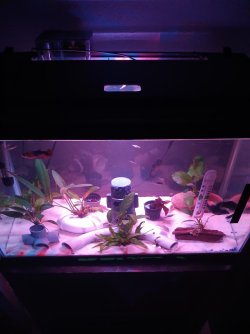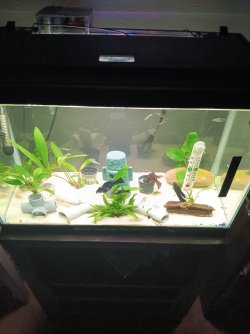You are using an out of date browser. It may not display this or other websites correctly.
You should upgrade or use an alternative browser.
You should upgrade or use an alternative browser.
Will 2 lights make my plants grow faster?
- Thread starter 16gallontanker
- Start date
WhistlingBadger
Professional Cat Herder
Retired Moderator ⚒️
Tank of the Month 🏆
Fish of the Month 🌟

- Joined
- Dec 18, 2011
- Messages
- 7,227
- Reaction score
- 13,838
- Location
- Where the deer and the antelope play
Good question, but one that doesn't have a simple answer.
In general, yes, most plants do better with brighter light, and multicolored lights can work well together. However, brighter light must be balanced with CO2 and nutrients in the water. When the three get out of balance, plants tend to struggle and algae tends to move in and take advantage. This is why high-tech tanks with fertilization and CO2 systems tend to have very bright lights. Lower tech tanks usually aren't quite as bright. Knowing more about your setup would help us give you better advice.
It will depend somewhat on what plants you have. Many plants seem to do better with brighter or dimmer light, and others are very adaptable. Also, it looks like your fish don't have many hiding places, and the bright lights might stress them.
My overall recommendation would be to try the bright lights for a week or two. If the fish seem uneasy, or if you notice more algae starting to grow, either dim them down a bit or lower the duration of your light period by a couple hours. Make a change, then wait a week or two before making any other changes. It can take a while to find the right balance.
In general, yes, most plants do better with brighter light, and multicolored lights can work well together. However, brighter light must be balanced with CO2 and nutrients in the water. When the three get out of balance, plants tend to struggle and algae tends to move in and take advantage. This is why high-tech tanks with fertilization and CO2 systems tend to have very bright lights. Lower tech tanks usually aren't quite as bright. Knowing more about your setup would help us give you better advice.
It will depend somewhat on what plants you have. Many plants seem to do better with brighter or dimmer light, and others are very adaptable. Also, it looks like your fish don't have many hiding places, and the bright lights might stress them.
My overall recommendation would be to try the bright lights for a week or two. If the fish seem uneasy, or if you notice more algae starting to grow, either dim them down a bit or lower the duration of your light period by a couple hours. Make a change, then wait a week or two before making any other changes. It can take a while to find the right balance.
I use full length Dawn to dusk LED lights, one per tank..., except I do have double lights on 2 tanks I have, that are 24 inches deep, one, a dark water tank, that is partially shaded with terrestrial plants, and has floating plants on the other half, that one I rarely have to scrape the glass... the other is a clear water tank, that is half shaded by terrestrial plants, the other half needs algae scraped off the glass on that side, about every other week... I think the modern LED lights offer plenty of light for plants in tanks of "normal" depth...
Last edited:
I agree, if you research the specific requirement of the plants you have, you might be surprised.
Low light plants will benefit greatly of longer expositions periods at lower intensity. The easiest way to do that is to have floating plants that creates shade for the lower demand plants under them and give the best impact on nutrients management. Leaving even less "space" for algae to exploit.
Low light plants will benefit greatly of longer expositions periods at lower intensity. The easiest way to do that is to have floating plants that creates shade for the lower demand plants under them and give the best impact on nutrients management. Leaving even less "space" for algae to exploit.
I forgot to mention another factor that I consider even if it's less prevalent in aquatic plants living in an aquarium, it is still there.
Vegetative versus Reproductive state of the plants. Too short lightning periods will cause them to go in Reproductive state. With time I understood that around 8 and less hours per days is enough to trigger the phenomena... For example an anubias trow off a flower that tries to reach the surface.
At this point you are slowly losing them. They will stop producing new leaves and growing then divert all their energy to produce fruits and even suck back the nutrients from their leaves to bloom and die.
So I try to maintain a photo period between 12-16 hours per day to prevent the plants to live too close between the threshold point and be sure that they are "convinced" to remain in a strong vegetative state.
And I'm very happy with my results. No more flowers just growth.
Vegetative versus Reproductive state of the plants. Too short lightning periods will cause them to go in Reproductive state. With time I understood that around 8 and less hours per days is enough to trigger the phenomena... For example an anubias trow off a flower that tries to reach the surface.
At this point you are slowly losing them. They will stop producing new leaves and growing then divert all their energy to produce fruits and even suck back the nutrients from their leaves to bloom and die.
So I try to maintain a photo period between 12-16 hours per day to prevent the plants to live too close between the threshold point and be sure that they are "convinced" to remain in a strong vegetative state.
And I'm very happy with my results. No more flowers just growth.
@Magnum Man mentioned depth of the water . That’s important . Light fizzles out the deeper the water is .
@Magnum Man mentioned depth of the water . That’s important . Light fizzles out the deeper the water is .
It's always very difficult to say from pictures. My tanks are very dark because of the subdued light. But I have only slow plants with no floating ones. And they are subject to mortal algae growth in high light. And still my picture come out too bright compared to reality. Even trying to fix them gets worse. Tannin can mess the colours to the point of changing it completely.
In these conditions. From a picture, You can only tell... If the substrate is glowing like the sun. You are going far too strong.
These kind of configurations are only available with nice controllable WRGB lights that can nearly emulate real daylight variations and all different intensity during a single day.
If you are stuck with fixed intensity, you can only deal with time period and shades, With high powered lights, fast growing floaters are the absolute killers at maintaining great conditions.
But I'm lazy I prefer to pay a little more to control the light instead of constantly pruning invaders.
16gallontanker
Fish Crazy
It's a standard 20 gallon fronm a tetra kit
Similar threads
- Replies
- 2
- Views
- 409
- Replies
- 5
- Views
- 952
- Replies
- 3
- Views
- 205


